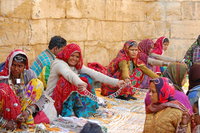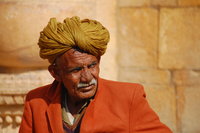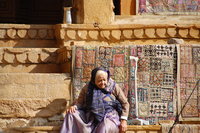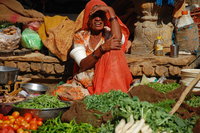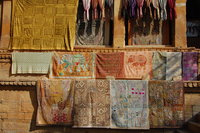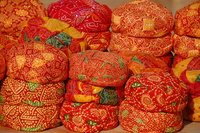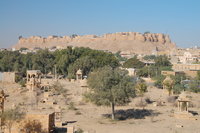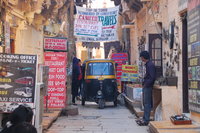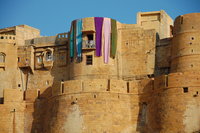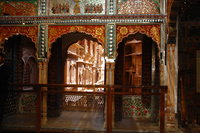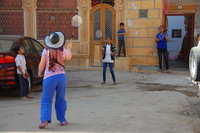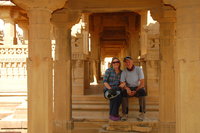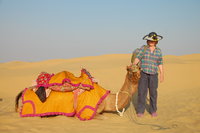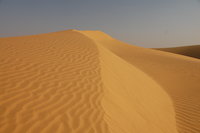The wind sighs and moans as it navigates the alleyways and the havelis, complaining of its age and the burden it carries. It is not malevolent or angry; neither is it soothing. It has a story to tell. It nudges those who will listen and whispers, redolent of riches and spices and of struggle and drought. It brings the smells of the desert, of the goat and the tinder-dry camp fire. It brings the sounds of the desert; the bark of the camel and the ululation of the sitar. As if in partnership with the sand, it eases the desert's fingers into the town as if, together, they wish to erase the life that has clung here for a thousand years. All is yellow and gold, and reflects the sand. The sand is everywhere, and the wind. This is Jaisalmer.
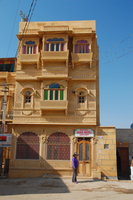
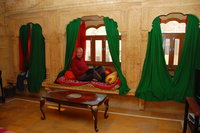
So, a six hour journey by bus west out of Jodhpur delivered us to pretty much the most western town in Rajasthan. It is one of the furthest points west you can go in India without running a goodly risk of being shot at! Outside town is a large (and probably strategic) military base that we'll say no more about. The most striking thing about Jaisalmer is its colour. Everywhere we've been so far, domestic construction has been an homage to concrete. Here, everything is a soft, yellowy gold which would be remarkable except for the fact that it would be difficult to make it any other colour. Difficult and pointless, since the swirling sands of the Thar Desert would pretty soon make it that colour anyway. The other thing that is different here is that there don't seem to be so many people employed to create dust - probably because nature has that covered. The Thar Desert is also known as the Great Indian Desert and it forms a natural boundary between India and Pakistan. The desert alone is ten times the size of the UK.
We made our reservation here at the Oasis Haveli Hotel quite a while ago as accommodation gets very busy over the holiday period. Indeed, we have noticed a dramatic increase in the number of people in the restaurants, meaning we are not the only people here right now - which makes a change. Some are from Europe (mainly French, although we still haven't figured out why) but most are Indians making the most of the holiday season and the opportunity to be rude to waiters and keep everyone awake all night.
We arrived on our wedding anniversary, so the first evening we thought we would go out for a curry!!! We splashed out on a bottle of Sauvignon Blanc from the Sula Vineyards (the only alcohol so far on this trip). They make a very pleasant wine although the price is less than pleasant, which is ironic since it is produced in India. This certainly pleased the waiter in our Haveli who seemed to think we would be doing this every night. He was most disappointed on Christmas eve when we retired at 8pm despite his best efforts to sell us two bottles of rum. Christmas dinner was baked potato, salad and pizza and a lemon soda.
Jaisalmer was founded in the 10th century. It lies on the Silk Route and served as a rest stop for traders moving goods between East and West. Camels would transport opium, silk, ivory, scented wood, dried fruits and numerous other items back and forth. All of them had to pass through Jaisalmer en route. In 1835 it was documented that half of all taxes raised in Jaisalmer came from a so-called "transit duty" levied on everything passing through the town.
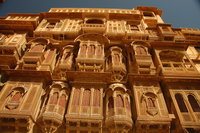
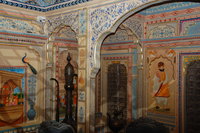
The local sand stone is very easy to work and yet resists the ravages of the wind and the result is a collection of very ornate Havelis that once belonged to the rich traders. In fact, the first building to be constructed in the desert outside the fort was to house the tax collectors! There are a number of very richly decorated havelis that can be visited. They are all impressive from the outside, but are in varying states of decay on the inside. Some guides lamented that they get absolutely no government funding to help with the preservation and restoration of their houses. Finally, we discovered why. The government owns its own haveli (the Patwon Ki) for which it charges the highest entrance fee (especially to foreigners). Of course, it is the best preserved inside and is rather a good museum. When asked why we should pay so much to visit the government haveli, the guys on the door proudly claimed that all the other havelis were "smelly and dirty". Not quite true, but it does show what can be done with a bit of money. Since tourism is so important to Jaisalmer now, it would be in everyone's interest to preserve as much heritage as possible, but clearly the powers that be don't see it that way. As an aside, the government is trying to curb the Indian tourist's urge to scrawl graffiti on everything by fining them. It is interesting to note that the fine is a mere half of what we have to pay in entrance fee. Perhaps we are allowed to carve our names in the sandstone.
There are some Jain temples here and they are pretty ornate. Again, they are constructed from sandstone rather than the marble we have seen up to now. You may remember, the Jain are the dudes who charge money for everything. We have given up paying for the privilege of wading around in pigeon excrement in our bare feet being banned from taking photographs.
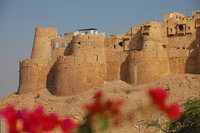
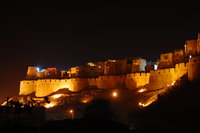
Of course there is a fort here, so you are treated to the obligatory photos. It looks a bit like a sand castle from a distance (which of course it is really). All forts in India seem to have a claim to fame and this one's is that there is a thriving local population who go about their business within its 5km long walls. There is a palace too, but the really novel thing about the so-called Golden Fort is the maze of winding streets that are home to a seemingly limitless number of shops, restaurants and hotels. Whilst a population of some 2000 does live here, it is probably fair to say that they all subsist on trade with tourists. It was fun to amble the narrow streets and alleys discovering hidden shops and the occasional view out over the wider city and the desert beyond. It seems that the fort is high on the tourist itinerary and coach loads of Indians turn up around lunch time making the place difficult to navigate and sending the shopkeepers into a frenzy. Apparently there is a special, one-off Christmas discount on all products (99%, honest!). For the benefit of the few western tourists that are here, the vendors have developed a very seasonal "Merry Christmas" opening to their sales pitch. Come 2pm and the coaches leave and we have the place to ourselves. The shopkeepers are then much more willing to chat as the day's work is over. Actually, even with the day trippers gone, it is still quite difficult to navigate the streets as they are often blocked by cows which are even more reluctant to move than the Indian tourists (although it is more acceptable to hit them with sticks).
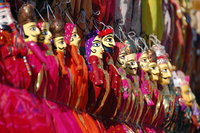
They say that Britain is a nation of shopkeepers and it seems as though most of them originated here. Trading is in the blood in Jaisalmer and everyone seems to be involved in manufacturing or selling something. Outside the fort entrance and throughout the city there are hundreds of shops specialising in various crafts like leather-work, tailoring, puppets, wood carving, etc. All the produce is made locally within the shops or sometimes by the shop keeper's family who live in a village out in the desert somewhere....except of course that it isn't. We repeatedly see the same items in shops all over Rajasthan and it is very hard to avoid the conclusion that there is a massive sweat-shop just outside Delhi manufacturing this stuff for the tourists. We are reminded of a similar scenario in Peru - just substitute Lima for Delhi (or perhaps don't!).
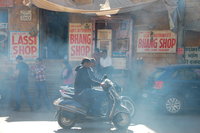
One thing we have seen here for the first time is a Government Approved Bhang shop. Bhang is cannabis in case you were wondering. Its original proponent was Shiva who apparently was very fond of the stuff; which should be a good enough endorsement for anyone! It's used in religious rituals to induce a meditative state. It is also consumed by those western tourists who choose to wear baggy juggling trousers and like to think they have "gone native". Rather oddly considering the approval of the shop, buying and selling Bhang is supposed to be illegal but apparently the government turns a blind eye. What this really means, of course, is that they just don't enforce the law very often - pretty much like all the other laws then.
Whilst on the subject of shopping, it is worth mentioning the money game. No one in this country will accept torn bank notes (except the bank and no one wants to go there as this would expose their earnings). As such, it is customary to try and palm off torn notes on other people. Often, a bunch of notes will be folded up when handed over in the hope that the recipient doesn't notice the duff one until too late. By far the easiest way to get rid of them though is to give them to a foreign tourist who is likely unaware of the problem until they come to try and spend them. Since we are now battle hardened veterans, we don't get caught out by this (any more). It has to be said that all you have to do when receiving a torn note is to hand it back at which point it is replaced with a good one accompanied by a wry grin. In our case, it is often accompanied by a look of surprise and faint embarrassment. Hindus are always telling us that "the guest is god" perhaps people don't like being caught out trying to rip off god!
It seems that all the tourists who come to Jaisalmer, lured by the promise of sand dunes, choose to go on what is called a camel safari. Actually, it's a trudge along a gravel track being led by a camel-herd followed by a quick lurch through some dunes. Apparently camels don't like trudging through sand (!) and tourists tend to fall off and hurt themselves. Also, invariably included in the safari package is a "cultural program", which is some dudes wailing to a drum/sitar combo, some people whirling around and some food. Since we had come all this way, we decided to give it a go.
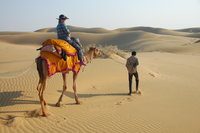
Apart from being smelly and having a rather unpleasant disposition, camels are simply pretty uncomfortable to ride. Surely when traversing the silk route, those in the know would rather walk and have the beast carry additional lucrative cargo. On this occasion, however, that cargo was us. If these animals are known as ships of the desert, it must have been blowing a force 6 in the Thar the day we went as the next day's hobbling proved!
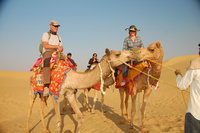
There are hundreds of camel safari operations in Jaisalmer and there seems to be a competition to claim access to the most remote and deserted dunes. Of course, on arrival, there is the obligatory bunch of shouting Indians and pile of plastic bottles. There are also wild claims about how much time you will spend riding your personal camel in the dunes. We had um'd and ah'd about whether to bother with the whole thing. Having been, we have solved the problem and know that it's not really worth it. If the Thar is ten times the size of the UK, then the bit of it that actually contains bona fide sand dunes is probably the size of Hyde Park and, having spent time in Namibia recently, we were rather blasé about the whole dune thing. Also, despite the touts' claims about extended rides, it turns out to be an advantage not to have too long on the creature and an hour or so turned out to be plenty. Having said all of this, we did have a bit of a laugh and spent the afternoon with a very pleasant couple from Bangalore who were very interesting to talk to.
The most fascinating aspect of the day, though, was when our Jeep driver (a mid-twenties sort of youth) refused to drive down a particular road as he had seen a bunch of kids approaching dragging a bundle of sticks. This is a very bad omen apparently and we absolutely had to find a different way out of town; there was no way he was driving down that road, it was simply too dangerous now. Of course, given the treacherous nature of Indian roads in general, we were the last people to try and disabuse him of this notion! Eventually we picked up a different road and the driver was very pleased to observe a water-tanker approaching from out of the desert, which is a very good omen. It was surprising to see such beliefs manifest in the younger generation. It must work though as we didn't crash once on the way back in the dark. We did come across a road-block at one point where we were advised there was shooting ahead. We pressed on regardless, which was a bit worrying, only to finally come across the film crew doing their thing! Hurrah for the water-tanker.
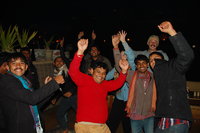
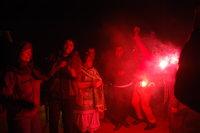
New Year's Eve meant there was a party at the hotel and we thought we would celebrate by having a curry! This involved the staff trying to sell as much liquor as they could to the guests whilst remaining completely sober themselves, but then acting much more wildly than any of the guests. We shudder to think what would have happened had they been drunk! Since we have been here a while, we were given some of their industrial house rum. We were also given some top-quality whiskey (still disgusting) by some visiting Indians from Delhi. Someone brought some fireworks and these were let off in a spectacularly dangerous and close-quarters fashion. One firework managed to punch a hole in a 2cm thick plywood table! The next morning, we made another discovery. The Indian addiction to noise extends to the TV mute button which would only fractionally decrease the volume of the garish game-show in the local café. Quelle horreur.
It is probably a sign that we have been in Jaisalmer too long that the hotel owners invited us to their house for the evening. Ostensibly this was to eat with them, but it pretty soon turned out that it was one of the children's birthday and we were special feature for his party. It turns out that the hotel owners are four brothers and they all live in the same house along with their spouses, two sisters and their spouses and about 130 children. You will recall that the guest is god, but they have a strange way of showing this. Megan was banished to the kitchen to "sit with the women", whilst Steve got to drink whiskey in the living room with the men whilst watching belly-dancing on Tata-Sky! Whilst the men rule the house on the face of it, Megan is clear that sitting in the kitchen laughing and joking in the warm was the better deal. The visit was not exactly what we had expected, but we did finally finish drinking and eat some food and it was very interesting to see inside a normal family home. They certainly seemed like a jolly bunch.
Next time, we take the slow mail train some 315km across the desert to try and catch a camel fair before heading back towards central Rajasthan to the holiest lake in India. We hope that this missive finds you well and that the new year has started auspiciously for everyone.
